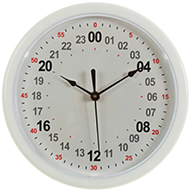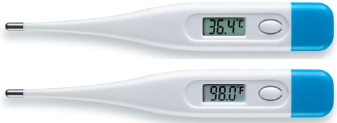6.4 Systems for Measuring Time and Temperature
Now that you understand basic mathematical principles, you can begin to apply them to pharmaceutical measurements, conversions, and calculations. In life and in pharmacy practice, different dimensions are measured—the dimensions of time, temperature, weight (liquid, solid, or gas), and volume (for each). The dimensions of distance (length), width, and speed are less used. There are several systems to measure the varied dimensions used in pharmacy practice, sometimes with differing systems used in other parts of the world than in the United States.

Twenty–four–hour clocks begin at midnight each day, and the first twelve hours until noon are similar to the normal clock. From noon to midnight, the counting continues after 12 instead of starting to count again.
Time
In the hospital setting, medication orders are commonly written with a 24-hour clock rather than the common 12-hour clock based on Greenwich mean time. Because medical care is around the clock, dosage administration schedules consider that 0000 is midnight and noon is the 1200 hour. The first two digits are the time in hours, and the second two digits are the time in minutes. The 24-hour clock, which is also known as military time, creates less confusion in pharmacies, hospitals, and other healthcare facilities because there is no need for a.m. or p.m.
 Pharm Fact
Pharm Fact
The 24-hour format for time originated as early as the Eleventh Dynasty in Egypt around 2100 BCE.
To switch from the 12-hour to the 24-hour clock, cut the 12 in 12:00 a.m. to 00 and start counting minutes and hours from there, dropping the colon and the a.m. or p.m., as seen in Table 6.3. After 12:59 p.m., just add 1200 to the 12-hour time until you get to 2359 and then start over.
 Name Exchange
Name Exchange
The 24-hour clock used in healthcare settings is also known as military time because the military uses the same system.
To convert military time to regular time, simply take the time after midnight (or 0000) and substitute the first 00s with 12, adding a colon and a.m. up until 0059 military. From 0100 to 1259, simply add the colon and a.m. after the first two numbers and the p.m. from 1201 to 1259. From 1300 on, subtract 1200, adding the colon and the p.m. at the end (see Table 6.3).
Table 6.3 Military Time Versus Greenwich Mean Time
24-Hour Clock |
12-Hour Clock |
|---|---|
0000 |
Midnight–12:00 a.m. |
0030 |
12:30 a.m. |
0100 (the first hour) |
1:00 a.m. |
0230 |
2:30 a.m. |
0600 (the 6th hour) |
6:00 a.m. |
0845 |
8:45 a.m. |
1200 (the 12th hour) |
Noon–12:00 p.m. |
1645 |
4:45 p.m. |
1800 (the 18th hour) |
6:00 p.m. |
2130 |
9:30 p.m. |
2300 (the 23rd hour) |
11:00 p.m. |
 For Good Measure
For Good Measure
The standard international notation for time uses the 24-hour clock and colons between hours, minutes, and seconds—hh:mm:ss—as in 02:30:00, which would be 2:30 a.m. Healthcare settings usually drop the colons and the seconds.
Example 11
At 0125, you receive the following order.
 Gentamicin 80 mg IV every 8 hours, administer at 0200, 1000, and 1800
Gentamicin 80 mg IV every 8 hours, administer at 0200, 1000, and 1800
The order was received at 1:25 a.m. according to the 12-hour clock. When should doses be delivered to the patient care unit by the same clock?
 Put Down Roots
Put Down Roots
The Romans used a 12-hour clock, and the Latin words ante meridiem (before midday) and post meridiem (after midday) became abbreviated as a.m. and p.m.
Using Table 6.3 and the conversion process, the first dose is to be immediately prepared and sent to the patient care unit to be given at 2:00 a.m. A follow-up dose is scheduled for 10:00 a.m. The final dose is scheduled for 1800. To convert any amounts over 1200, subtract 12 hours and add p.m.
1800 – 1200 = 600, or 600 p.m.
So 6:00 p.m. will be the last dose before more medication will be delivered to the patient care unit.
Temperature
The United States is one of the few countries in the world that commonly uses Fahrenheit as its temperature scale. The Fahrenheit temperature scale assigns 32°F as the temperature at which water freezes to ice and 212°F as the temperature at which water boils, with the difference between these two extremes of 180°F.

Pharmacy technicians may be asked to help patients convert between temperature readings in degrees Celsius and Fahrenheit. This calculation must be done carefully. Some thermometers display both.
 For Good Measure
For Good Measure
Depending on whether you are converting from standard time to military time or vice versa, you will either add 12 hours in the p.m. or subtract them. For practice, try setting your phone to international time to get used to the 24-hour clock!
In contrast, the Celsius temperature scale is commonly used in Europe and internationally in science. In 1742, the Swedish astronomer Anders Celsius proposed a thermometer scale with a difference of 100 degrees between freezing and boiling. He designated the freezing point of pure water at sea level to be zero degrees (0°C), the boiling point to be 100°C, and all things to be measured in 100 equal increments within that temperature span, and in equal increments above and below it. Celsius is the scale generally used in pharmacy and medicine. Many thermometers show both Celsius and Fahrenheit.
An understanding of the Fahrenheit and Celsius temperature scales is important to the proper storage of medications. Maintaining refrigerator and freezer equipment at their appropriate temperatures is an important responsibility. Technicians monitor the refrigerators and document the temperatures once or twice daily, depending on their pharmacy’s protocol. Most refrigerators in the pharmacy need to maintain a temperature of 2°C to 8°C. Technicians can find the storage temperature requirements for each drug in Celsius on the manufacturers’ drug package inserts. In addition, technicians have the responsibility of monitoring and documenting the temperature conditions of the freezer medications. In the hospital, they may need to also monitor the refrigerated medications on each nursing unit.
 For Good Measure
For Good Measure
The conversion from Celsius to Fahrenheit uses multiplication and addition. The Fahrenheit to Celsius equation uses division and subtraction.
A temperature log documents the refrigerator and freezer temperatures on a daily basis. Currently, the temperature logs in most pharmacies document to the tenth place for accuracy. If the log does not require a decimal, the temperature should be rounded off.
As a pharmacy technician, you must be able to perform conversions between the Celsius and the Fahrenheit scales. Table 6.4 shows the temperature equivalencies between these two scales. As you can see, every 5°C change in temperature is equivalent to a 9°F change.
In addition to using this chart, there are several mathematical methods of converting from Fahrenheit to Celsius and vice versa. If you begin with a Fahrenheit measurement and are converting to a Celsius measurement, you can use the following equation.
(°F – 32°) ÷ 1.8 = y°C
If you begin with a Celsius reading and are converting to Fahrenheit, use the following equation.
(°C × 1.8) + 32° = z°F
Table 6.4 Temperature Equivalencies between Celsius and Fahrenheit
Celsius |
Fahrenheit |
|---|---|
0°C |
32°F |
5°C |
41°F |
10°C |
50°F |
15°C |
59°F |
20°C |
68°F |
Example 12
Convert 70°F to degrees Celsius using this equation: (°F – 32°) ÷ 1.8 = z°C.
Step 1 |
(70°F – 32°) ÷ 1.8 = z°C |
Step 2 |
38° ÷ 1.8 = 21.1°C |
Step 3 |
21.1°C, rounded down to 21°C, so 70°F = approximately 21°C. |
Example 13
Convert 30°C to degrees Fahrenheit using this equation: (°C × 1.8) + 32° = z°F.
Step 1 |
(30°C × 1.8) + 32° = z°F |
Step 2 |
54° + 32° = 86°F, so 30°C = 86°F. |
 Math Morsel
Math Morsel
An alternative method of conversion between Fahrenheit and Celsius uses the following algebraic equation: °F × 5 = °C × 9 + 160.
Example 14
According to the Enbrel package insert, the manufacturer requires that a syringe of this expensive biotechnology drug must be stored at a temperature of 2° to 8°C. What should the range of the Fahrenheit temperature setting be on the thermostat in the refrigerator?
 Practice Tip
Practice Tip
Be sure to become proficient at temperature conversions. It is almost guaranteed that there will be at least one question on the certification exam! Remember the refrigerated temperature of 2–8° C is equal to 36–46° F—the storage of many medications including insulin.
Step 1 |
Convert the degrees Celsius at the low end of the range using this equation: (°C × 1.8) + 32° = z°F. (2°C × 1.8) + 32° = z°F 3.6° + 32° = 35.6°F 2°C = 35.6°F, rounded up to 36°F. |
Step 2 |
Convert the degrees Celsius at the high end of the range using this equation: (°C × 1.8) + 32° = z°F. (8°C × 1.8) + 32° = z°F 14.4° + 32° = 46.4°F 8°C = 46.4°F, rounded down to 46°F (depending on the device). |
The pharmacy technician should be sure that the thermostat setting in the refrigerator is between 36° and 46°F.
Example 15
An anxious parent telephones the pharmacy on a Saturday night. Their six-month-old child has a fever. The only thermometer they have records a temperature of 38.5°C. Their pediatrician told them to call if the child’s temperature reached 101°F. What is the child’s temperature in degrees Fahrenheit? Should the parent call the pediatrician?
Step 1 |
Use this equation: (°C × 1.8) + 32° = z°F (38.5°C × 1.8) + 32° = z°F |
Step 2 |
69.3° + 32° = 101.3°F; 38.5°C = 101.3°F, rounded down to 101°F. Therefore, the parent should call the child’s pediatrician. |